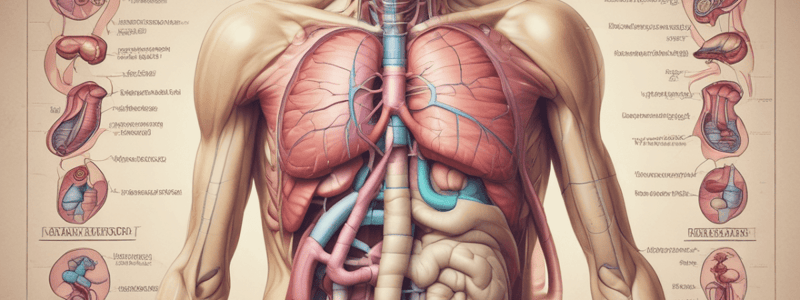Podcast
Questions and Answers
What is the primary type of muscle that composes the upper esophageal sphincter?
What is the primary type of muscle that composes the upper esophageal sphincter?
- Skeletal muscle (correct)
- Connective tissue
- Cardiac muscle
- Smooth muscle
Which component ensures that food flows only in one direction through the esophagus?
Which component ensures that food flows only in one direction through the esophagus?
- Smooth muscle lining
- Ciliary muscle
- Thoracic diaphragm
- Esophageal sphincters (correct)
What is unique about the lower esophageal sphincter compared to typical sphincters?
What is unique about the lower esophageal sphincter compared to typical sphincters?
- It is under involuntary control.
- It does not open and close like a typical sphincter. (correct)
- It is made up of a single circular muscle layer.
- It is composed entirely of cardiac muscle.
What type of muscle is primarily found in the lower esophageal region?
What type of muscle is primarily found in the lower esophageal region?
How is the upper esophageal sphincter controlled?
How is the upper esophageal sphincter controlled?
What happens when the muscles of the upper esophageal sphincter relax?
What happens when the muscles of the upper esophageal sphincter relax?
What distinguishes the lower esophageal sphincter from typical sphincters?
What distinguishes the lower esophageal sphincter from typical sphincters?
What characteristic of sphincters is described in the content?
What characteristic of sphincters is described in the content?
What role does the diaphragm play in the respiratory process?
What role does the diaphragm play in the respiratory process?
Why do rodents and horses do not experience heartburn as humans do?
Why do rodents and horses do not experience heartburn as humans do?
What is peristalsis in the context of the esophagus?
What is peristalsis in the context of the esophagus?
How is the esophagus divided in terms of muscle type?
How is the esophagus divided in terms of muscle type?
What condition can occur from the upward movement of the esophagus through the lower esophageal sphincter?
What condition can occur from the upward movement of the esophagus through the lower esophageal sphincter?
Which part of the esophagus is primarily under voluntary control?
Which part of the esophagus is primarily under voluntary control?
What happens when the diaphragm contracts during breathing?
What happens when the diaphragm contracts during breathing?
Which of the following is a characteristic of the lower esophageal sphincter?
Which of the following is a characteristic of the lower esophageal sphincter?
What is the primary composition of the middle 1/3 of the esophagus?
What is the primary composition of the middle 1/3 of the esophagus?
What effect does relaxing one part of the esophagus while contracting another have on food movement?
What effect does relaxing one part of the esophagus while contracting another have on food movement?
Flashcards are hidden until you start studying
Study Notes
Esophagus Overview
- The esophagus connects the mouth to the stomach, facilitating food passage.
- It starts from the mouth and extends down to the gastric region, with sphincters at both ends.
Sphincters of the Esophagus
- Upper Esophageal Sphincter: Composed of skeletal muscle, allowing voluntary control over food movement.
- Lower Esophageal Sphincter: Functions differently than a typical sphincter; consists of a muscle sheet rather than a circular muscle ring.
- The diaphragm encircles the lower esophageal sphincter, contributing to its function and position.
Hiatal Hernia and Gastroesophageal Reflux Disease
- Hiatal hernia occurs when the esophagus dislocates through the lower esophageal sphincter, potentially causing reflux of gastric acid.
- This condition can lead to symptoms like heartburn, especially in humans, but not in certain animals like rodents and horses, which have a true sphincter.
Functionality of the Esophagus
- The esophagus plays a minimal role in food processing; its primary function is to transport food via peristalsis.
- Peristalsis: Defined as wave-like muscle contractions that propel food down the esophagus.
Muscle Composition of the Esophagus
- The esophagus is divided into three sections, each with distinct muscle types:
- Upper Third: Composed entirely of skeletal muscle, allowing voluntary control.
- Middle Third: A blend of skeletal and smooth muscle, providing a mix of voluntary and involuntary control.
- Lower Third: Comprised solely of smooth muscle, functioning involuntarily.
Summary of Control Mechanisms
- The esophagus operates under a coordinated system, where contraction at one segment facilitates relaxation in the subsequent segment to enable efficient food movement.
Studying That Suits You
Use AI to generate personalized quizzes and flashcards to suit your learning preferences.




